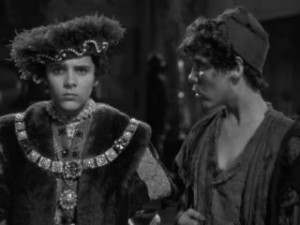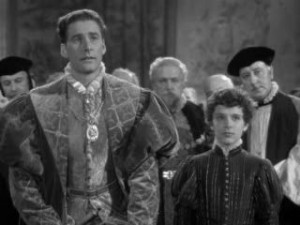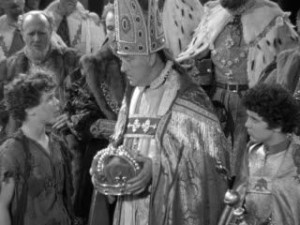In one of Flynn’s few bits of action, he kills the Captain of the Guard in a duel when the captain prepares to murder the boy after he has said his prayers. Since the king has died, Hendon and the prince race to Westminster Abbey to stop Tom’s mistaken coronation. Before the archbishop (Halliwell Hobbes) can lower the crown on Tom’s head, he is stopped by Edward’s challenge.
 But how can Edward prove he’s the real prince? Several statements prove inconclusive until Tom suggests that the real prince would know the hiding place of the Great Seal of England, since they had been cracking walnuts with it. “Think, you majesty,” he says. A runner makes an unsuccessful dash on horseback from the cathedral to Windsor and back before Edward remembers the correct hiding place—in the right calf of a suit of armor.
But how can Edward prove he’s the real prince? Several statements prove inconclusive until Tom suggests that the real prince would know the hiding place of the Great Seal of England, since they had been cracking walnuts with it. “Think, you majesty,” he says. A runner makes an unsuccessful dash on horseback from the cathedral to Windsor and back before Edward remembers the correct hiding place—in the right calf of a suit of armor.
Knowing he has little to do, Flynn takes everything leisurely, with his usual nonchalance and grace. The dining scene with the demoted prince is perhaps Flynn’s best moment. There is a gentle humor and a clear bond between the two; he handles the boy with the charm and tenderness the actor usually lavishes on a woman. And there is a female role, no doubt written into the script for him. Flynn treats the inn barmaid (Phyllis Barry) with the same casual assurance he was no doubt showing that current girlfriend waiting on the set, she anticipating a Flynn specialty between takes.
Perhaps not surprising, many of Flynn’s fellow players make more of an impression than he.
 The Mauch twins are excellent, comfortably natural as kids, without the adult-like sophistication that afflicts so many child performers. They seem to be having great fun. They are much better child actors than, say, Jackie Cooper in the 1934 Treasure Island, or Mark Lester in the 1977 remake of the Twain story under the title Crossed Swords, which also stars Oliver Reed as Hendon and Charlton Heston as Henry VIII.
The Mauch twins are excellent, comfortably natural as kids, without the adult-like sophistication that afflicts so many child performers. They seem to be having great fun. They are much better child actors than, say, Jackie Cooper in the 1934 Treasure Island, or Mark Lester in the 1977 remake of the Twain story under the title Crossed Swords, which also stars Oliver Reed as Hendon and Charlton Heston as Henry VIII.
Besides Love, Hale and Hobbes, the film is replete with many of those Golden Age supporting players, including Henry Stephenson, Ivan Simpson, Fritz Leiber, Forrester Harvey, Harry Cording, Robert Warwick, Holmes Herbert and Ian Wolfe.
Sol Polito, who had just photographed The Charge of the Light Brigade, adds his usual competence to the proceedings, and William Keighley’s somewhat slow-paced direction well suits the general low-key aura of the film, its humor and the long, line-heavy scenes.
 Perhaps the best ingredient of the film is the wonderfully apt score by Erich Wolfgang Korngold. The composer had a childlike disposition in many respects and took naturally, almost instinctively, to the world of the two boys and their fairy tale-like story. This is Korngold’s most charming film score, one of his best and, surprisingly, one of the most neglected among his best films. Viennese and Old World at many turns.
Perhaps the best ingredient of the film is the wonderfully apt score by Erich Wolfgang Korngold. The composer had a childlike disposition in many respects and took naturally, almost instinctively, to the world of the two boys and their fairy tale-like story. This is Korngold’s most charming film score, one of his best and, surprisingly, one of the most neglected among his best films. Viennese and Old World at many turns.
“The Boys Go to Play” was always the most popular bit from the score, issued on LP long before large chunks were recorded. An extended suite from an RCA-German release offers excellent sound by recording engineer Geert Puhlmann and beautiful playing by the Brandenburg Philharmonic under William Stromberg. Later, the Tribute label recorded the entire score, also with Stromberg, now conducting the Moscow Symphony. Both recordings are topnotch. The other half of the RCA presents a “theme” tie-in, Max Steiner’s score for The Adventures of Mark Twain.
Korngold reused the main theme of The Prince and the Pauper, heard immediately in the main title, in the finale of his 1945 Violin Concerto. The score is practically a set of variations on the theme, variants of it coming especially to the fore, now with piano, woodwinds and pizzicato strings, when the runner checks on the Great Seal.
There are at least two suspicious similarities to so-called classical music. Part of the music associated with Tom Canty, a pizzicato bass passage (once, when he is sitting by the fire reading), is reminiscent of a rhythm in Act I, scene 3, of Richard Wagner’s Siegfried, the third in the four-opera cycle of his Ring of the Nibelungen. The violin solo during Flynn’s scene with the barmaid recalls the opening theme—also in the solo violin—of the fourth movement of Gustav Mahler’s Seventh Symphony. Korngold was creatively drawn to Mahler, as well to Richard Strauss and Giacomo Puccini, and their fingerprints occasionally show in his music. Erich must have heard the symphony in Europe before first coming to the U.S. in 1934.
1937 would be followed by—who would’ve guessed!—1938. And Errol Flynn’s first film of the new year, The Adventures of Robin Hood, would be the closest he ever came to the perfect vehicle—everything first-rate: the acting, the lush production, his co-stars, splendid Technicolor, a first-class adventure and heroic music, again by Korngold.